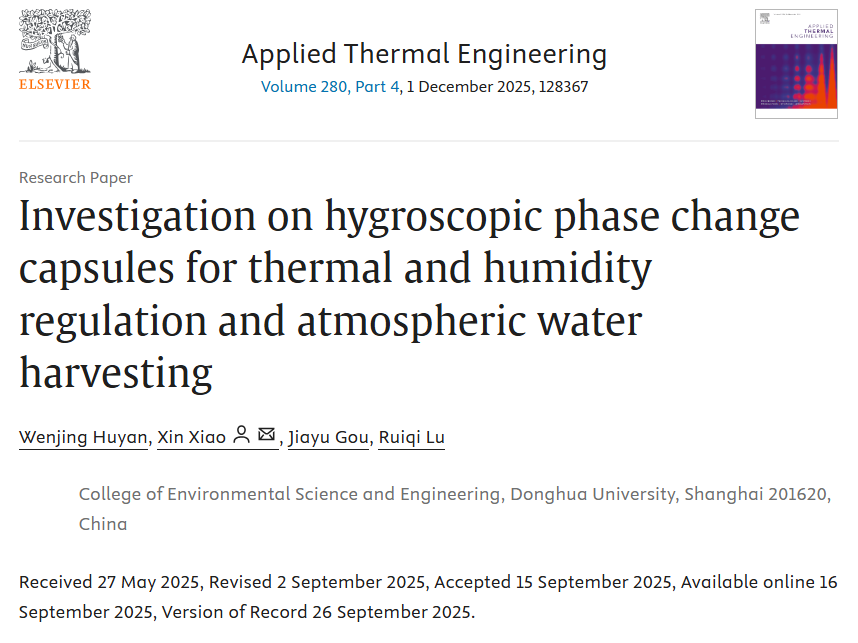Recent research led by Professor Xiao Xin's team from the College of Environment has achieved significant progress in hygroscopic phase-change materials and atmospheric water harvesting. Their findings, titled ‘Investigation on hygroscopic phase change capsules for thermal and humidity regulation and atmospheric water harvesting,’ have been published in the renowned journal Applied Thermal Engineering.
The paper lists Huyan Wenjing, a Class of 2022 undergraduate from the Building Environment and Engineering major, as first author, with fellow undergraduates Gou Jiayu and Lu Ruiqi as co-authors. Professor Xiao Xin served as the corresponding author. This work was supported by the National College Student Innovation and Entrepreneurship Training Program, and all three students have previously earned honors including a National Second Prize in the National University Student Social Practice and Science Contest on Energy Saving and Emission Reduction and a Provincial First Prize in the National College Student Competition on Energy Economics.



(Certificate of Award)
This study addresses the increasingly severe global challenges of building energy consumption and water scarcity by innovatively developing a novel hygroscopic phase-change capsule material, offering a groundbreaking technical pathway for achieving building energy efficiency and atmospheric water harvesting. The research team addressed the limitation of single-functionality in traditional materials by ingeniously coupling hygroscopic and phase-change materials, successfully creating a novel dual-functional composite. This material not only effectively regulates indoor temperature and humidity to reduce air conditioning energy consumption but also captures moisture from the air, enabling green water harvesting. Key breakthroughs in this research include:
1) Successful construction of a synergistic material system integrating moisture absorption and phase change functions, achieving a moisture absorption capacity of 0.58 g/g under 80% humidity conditions and demonstrating outstanding humidity regulation capabilities;
2) Innovative encapsulation of phase change materials within a sodium alginate three-dimensional network structure, combined with an ultrasonic-assisted impregnation process, resolving technical challenges such as leakage and short lifespan common in traditional materials;
3) A prototype passive atmospheric water collection device based on this material was successfully developed, enabling continuous water production without external energy input.
The device exhibits high-efficiency atmospheric water harvesting performance, achieving a daily water yield of 0.54 L/kg and a water desorption rate as high as 95% under 6 hours of solar drive. After 50 cycles of testing, the material maintained over 95% of its performance, demonstrating excellent stability and durability.
|
|
(a) | (b) |
|
|
(c) | (d) |
| |
(e) | |
Air-to-Water Moisture Collection Rate Curves: (a) to (e) Five typical hourly moisture recovery rate curves |
Link to the article:https://doi.org/10.1016/j.applthermaleng.2025.128367
